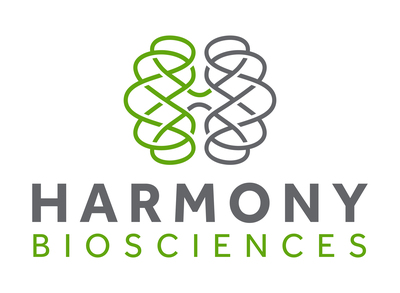PLYMOUTH MEETING, Pa. , Oct. 1, 2024 /PRNewswire/ — Harmony Biosciences Holdings, Inc. (Nasdaq: HRMY), will be providing a comprehensive pipeline update at its Investor Day event today, showcasing new data from its orexin-2 receptor agonist, next-generation pitolisant programs, and long-term extension data from its pitolisant program in idiopathic hypersomnia. The company will also provide program updates from its strategic acquisitions in Fragile X syndrome (FXS) and rare epilepsies, which have strengthened its late-stage development pipeline.
“Harmony Biosciences has transformed into an innovative, catalyst-rich, self-funding biotech company focused on patient impact and long-term value creation,” said Jeffrey M. Dayno , M.D., President and Chief Executive Officer of Harmony Biosciences. “We strategically expanded and advanced our pipeline, with near-term catalysts positioned to deliver one or more new product or indication launches each year over the next five years, positioning Harmony to generate over $3 billion in potential annual revenue. Our expertise in CNS and proven track record of success, combined with our unique commercial model, provide a strong foundation to efficiently scale beyond sleep/wake. I am extremely proud of what the Harmony team has accomplished over the past year, and we are just getting started in our growth story.”
The event will feature presentations from Harmony’s executive leadership team and experts in the fields of sleep disorders, Fragile X syndrome and developmental epileptic encephalopathies, highlighting Harmony’s expansion and diversification of its pipeline, continued commitment to innovation, and focus on driving value for patients and shareholders.
Key Highlights:
Orexin-2 agonist program: New data show BP1.15205 (formerly TPM-1116) is based on a novel chemical scaffold and has demonstrated greater potency compared to all publicly disclosed data on orexin-2 agonists, with the potential to be best-in-class. Pitolisant in Idiopathic Hypersomnia: New data show robust and sustained efficacy of pitolisant in patients with idiopathic hypersomnia in the Long-Term Extension study; mean improvement in Epworth Sleepiness Scale (ESS) was ~9 points from baseline out beyond one year, with the majority of patients achieving normal levels of wakefulness. Pitolisant-HD program: Preliminary data confirm safety up to five times the highest labeled dose of WAKIX, establishing the safety margins for the pitolisant-HD development program. Market research indicates healthcare professionals view HD as a superior product profile and anticipate high uptake of pitolisant-HD for all patients, including patients on WAKIX. Payers also see value in the HD profile and anticipate broad access to pitolisant-HD both pre- and post-WAKIX LOE. Fragile X syndrome program (ZYN-002): A prespecified ad hoc analysis from the Phase 2 CONNECT-FX in Fragile X syndrome study (published in 2022) showed that patients with complete methylation of FMR1 gene showed a 40% median improvement in socially avoidant behaviors (p =0.027) on the Aberrant Behavior Checklist-Community FXS Specific (ABC-CFXS ) Social Avoidance subscale; this and other learnings from this trial have informed the design and selection of the primary endpoint for the Phase 3 RECONNECT study, which is on track for topline data in mid-2025. EPX-100 development program: New safety and tolerability data on EPX-100, a potent, oral, centrally acting serotonin (5HT2) agonist currently in a pivotal registrational trial (ARGUS) for Dravet syndrome (DS), shows a favorable risk/benefit profile for EPX-100 compared to select approved drugs for DS and Lennox-Gastaut syndrome (LGS); topline data in DS is expected in 2026, and a pivotal Phase 3 trial for LGS is on track to initiate later this year. The replay webcast and presentation slides from this event will be available on Harmony Biosciences’ investor relations at https://ir.harmonybiosciences.com/ .
About WAKIX® (pitolisant) Tablets
WAKIX, a first-in-class medication, is approved by the U.S. Food and Drug Administration for the treatment of excessive daytime sleepiness (EDS) or cataplexy in adult patients with narcolepsy and for the treatment of EDS in pediatric patients 6 years of age and older with narcolepsy. It was granted orphan drug designation for the treatment of narcolepsy in 2010, and breakthrough therapy designation for the treatment of cataplexy in 2018. WAKIX is a selective histamine 3 (H₃) receptor antagonist/inverse agonist. The mechanism of action of WAKIX is unclear; however, its efficacy could be mediated through its activity at H₃ receptors, thereby increasing the synthesis and release of histamine, a wake promoting neurotransmitter. WAKIX was designed and developed by Bioprojet (France ). Harmony has an exclusive license from Bioprojet to develop, manufacture and commercialize pitolisant in the United States.
INDICATIONS AND USAGE
WAKIX is indicated for the treatment of excessive daytime sleepiness (EDS) or cataplexy in adult patients with narcolepsy and for the treatment of excessive daytime sleepiness (EDS) in pediatric patients 6 years of age and older with narcolepsy.
IMPORTANT SAFETY INFORMATION
Contraindications
WAKIX is contraindicated in patients with known hypersensitivity to pitolisant or any component of the formulation. Anaphylaxis has been reported. WAKIX is also contraindicated in patients with severe hepatic impairment.
Warnings and Precautions
WAKIX prolongs the QT interval. Avoid use of WAKIX in patients with known QT prolongation or in combination with other drugs known to prolong the QT interval. Avoid use in patients with a history of cardiac arrhythmias, as well as other circumstances that may increase the risk of the occurrence of torsade de pointes or sudden death, including symptomatic bradycardia, hypokalemia or hypomagnesemia, and the presence of congenital prolongation of the QT interval.
The risk of QT prolongation may be greater in patients with hepatic or renal impairment due to higher concentrations of pitolisant; monitor these patients for increased QTc. Dosage modification is recommended in patients with moderate hepatic impairment and moderate or severe renal impairment. WAKIX is contraindicated in patients with severe hepatic impairment and not recommended in patients with end-stage renal disease (ESRD).
Adverse Reactions
In the placebo-controlled clinical trials conducted in adult patients with narcolepsy with or without cataplexy, the most common adverse reactions (≥5% and at least twice placebo) for WAKIX were insomnia (6%), nausea (6%), and anxiety (5%). Other adverse reactions that occurred at ≥2% and more frequently than in patients treated with placebo included headache, upper respiratory tract infection, musculoskeletal pain, heart rate increased, hallucinations, irritability, abdominal pain, sleep disturbance, decreased appetite, cataplexy, dry mouth, and rash.
In the placebo-controlled phase of the clinical trial conducted in pediatric patients 6 years and older with narcolepsy with or without cataplexy, the most common adverse reactions (≥5% and greater than placebo) for WAKIX were headache (19%) and insomnia (7%). The overall adverse reaction profile of WAKIX in the pediatric clinical trial was similar to that seen in the adult clinical trial program.
Drug Interactions
Concomitant administration of WAKIX with strong CYP2D6 inhibitors increases pitolisant exposure by 2.2-fold. Reduce the dose of WAKIX by half.
Concomitant use of WAKIX with strong CYP3A4 inducers decreases exposure of pitolisant by 50%. Dosage adjustments may be required.
H1 receptor antagonists that cross the blood-brain barrier may reduce the effectiveness of WAKIX. Patients should avoid centrally acting H1 receptor antagonists.
WAKIX is a borderline/weak inducer of CYP3A4. WAKIX may reduce the effectiveness of sensitive CYP3A4 substrates, including hormonal contraceptives. Patients using hormonal contraception should be advised to use an alternative non-hormonal contraceptive method during treatment with WAKIX and for at least 21 days after discontinuing treatment.
Use in Specific Populations
There is a pregnancy exposure registry that monitors pregnancy outcomes in women who are exposed to WAKIX during pregnancy. Patients should be encouraged to enroll in the WAKIX pregnancy registry if they become pregnant. To enroll or obtain information from the registry, patients can call 1-800-833-7460.
The safety and effectiveness of WAKIX have not been established for treatment of excessive daytime sleepiness in pediatric patients less than 6 years of age with narcolepsy.
The safety and effectiveness of WAKIX have not been established for treatment of cataplexy in pediatric patients with narcolepsy.
WAKIX is extensively metabolized by the liver. WAKIX is contraindicated in patients with severe hepatic impairment. Dosage adjustment is recommended in patients with moderate hepatic impairment.
WAKIX is not recommended in patients with end-stage renal disease. Dosage adjustment of WAKIX is recommended in patients with eGFR <60 mL/minute/1.73 m 2 . Dosage reduction is recommended in patients known to be poor CYP2D6 metabolizers; these patients have higher concentrations of WAKIX than normal CYP2D6 metabolizers. Please see the Full Prescribing Information for WAKIX for more information. To report suspected adverse reactions, contact Harmony Biosciences at 1-800-833-7460 or the FDA at 1-800-FDA-1088 or www.fda.gov/medwatch . About Narcolepsy Narcolepsy is a rare, chronic, debilitating neurological disease of sleep-wake state instability that impacts approximately 170,000 Americans and is primarily characterized by excessive daytime sleepiness (EDS) and cataplexy – its two cardinal symptoms – along with other manifestations of REM sleep dysregulation (hallucinations and sleep paralysis), which intrude into wakefulness. EDS is the inability to stay awake and alert during the day and is the symptom that is present in all people living with narcolepsy. In most patients, narcolepsy is caused by the loss of hypocretin/orexin, a neuropeptide in the brain that supports sleep-wake state stability. This disease affects men and women equally, with typical symptom onset in adolescence or young adulthood; however, it can take up to a decade to be properly diagnosed. About Idiopathic Hypersomnia Idiopathic Hypersomnia (IH) is a rare and chronic neurological disease that is characterized by excessive daytime sleepiness (EDS) despite sufficient or even long sleep time. EDS in IH cannot be alleviated by naps, longer sleep or more efficient sleep. People living with IH experience significant EDS along with the symptoms of sleep inertia (prolonged difficulty waking up from sleep) and 'brain fog' (impaired cognition, attention, and alertness). The cause of IH is unknown, but it is likely due to alterations in areas of the brain that stabilize states of sleep and wakefulness. IH is one of the central disorders of hypersomnolence and, like narcolepsy, is a debilitating sleep disorder that can result in significant disruption in daily functioning. About ZYN-002 ZYN-002 is the first-and-only pharmaceutically manufactured synthetic cannabidiol devoid of THC and formulated as a patent-protected permeation-enhanced gel for transdermal delivery through the skin and into the circulatory system. The product is manufactured through a synthetic process in a cGMP facility and is not extracted from the cannabis plant. ZYN-002 does not contain THC, the compound that causes the euphoric effect of cannabis, and has the potential to be a nonscheduled product if approved. Cannabidiol, the active ingredient in ZYN-002, has been granted orphan drug designation by the United States Food and Drug Administration (FDA) and the European Medicines Agency (EMA) for the treatment of FXS and for the treatment of 22q. Additionally, ZYN-002 has received FDA Fast Track designation for the treatment of behavioral symptoms in patients with FXS. About Fragile X Syndrome Fragile X syndrome (FXS) is a rare genetic disorder that is the leading known cause of both inherited intellectual disability and autism spectrum disorder. The disorder negatively affects synaptic function, plasticity and neuronal connections, and results in a spectrum of intellectual disabilities and behavioral symptoms, such as social avoidance and irritability. While the exact prevalence is unknown, upwards of 80,000 patients in the U.S. and 121,000 patients in the European Union and the UK are believed to have FXS, based on FXS prevalence estimates of approximately 1 in 4,000 to 7,000 in males and approximately 1 in 8,000 to 11,000 in females. There is a significant unmet medical need in patients living with FXS as there are currently no FDA approved treatments for this disorder. FXS is caused by a mutation in FMR1, a gene which modulates a number of systems, including the endocannabinoid system, and most critically, codes for a protein called FMRP. The FMR1 mutation manifests as multiple repeats of a DNA segment, known as the CGG triplet repeat, resulting in deficiency or lack of FMRP. FMRP helps regulate the production of other proteins and plays a role in the development of synapses, which are critical for relaying nerve impulses, and in regulating synaptic plasticity. In people with full mutation of the FMR1 gene, the CGG segment is repeated more than 200 times, and in most cases causes the gene to not function. Methylation of the FMR1 gene also plays a role in determining functionality of the gene. In approximately 60% of patients with FXS, who have complete methylation of the FMR1 gene, no FMRP is produced, resulting in dysregulation of the systems modulated by FMRP. About Clemizole Hydrochloride (EPX-100) EPX-100, clemizole hydrochloride, is under development for the treatment of Dravet syndrome (DS) and Lennox-Gastaut syndrome (LGS). EPX-100 acts by targeting central 5-hydroxytryptamine receptors to modulate serotonin signaling. The drug candidate is administered orally twice a day in a liquid formulation and has been developed based on a proprietary phenotype-based zebrafish drug screening platform. DS is caused by a loss of function mutation in the SCN1A gene, and scn1 mutant zebrafish replicate the genetic etiology and phenotype observed in the majority of DS patients. The scn1Lab mutant zebrafish model that expresses voltage gated sodium channels has been used for high-throughput screening of compounds that modulate Nav1.1 in the central nervous system. About Dravet Syndrome Dravet syndrome (DS) is a severe and progressive epileptic encephalopathy that begins in infancy and causes significant impact on patient functioning. DS begins in the first year of life and is characterized by high seizure frequency and severity, intellectual disability, and a risk of sudden unexpected death in epilepsy. Approximately 85% of Dravet Syndrome cases are caused by de novo loss-of-function (LOF) mutations in a voltage-gated sodium channel gene, SCN1A1. DS has an estimated incidence rate of 1:15,700. About Lennox-Gastaut Syndrome Lennox-Gastaut syndrome (LGS) is a rare and drug-resistant epileptic encephalopathy characterized by onset in children between 3-5 years of age. The underlying cause of LGS is unknown and can be related to a wide range of factors including genetic differences and structural differences in the brain. As a result, patients experience multiple seizure types, including atonic seizures, and developmental, cognitive, and behavioral issues. LGS affects approximately 48,000 patients in the U.S. About Harmony Biosciences Harmony Biosciences is a pharmaceutical company dedicated to developing and commercializing innovative therapies for patients with rare neurological diseases who have unmet medical needs. Driven by novel science, visionary thinking, and a commitment to those who feel overlooked, Harmony Biosciences is nurturing a future full of therapeutic possibilities that may enable patients with rare neurological diseases to truly thrive. Established by Paragon Biosciences, LLC, in 2017 and headquartered in Plymouth Meeting, PA , we believe that when empathy and innovation meet, a better future can begin; a vision evident in the therapeutic innovations we advance, the culture we cultivate, and the community programs we foster. For more information, please visit www.harmonybiosciences.com . Forward Looking Statement: This presentation includes forward‐looking statements within the meaning of the Private Securities Litigation Reform Act of 1995. All statements other than statements of historical facts contained in these materials or elsewhere, including statements regarding Harmony Biosciences Holdings, Inc.'s (the "Company") future financial position, business strategy and plans and objectives of management for future operations, should be considered forward-looking statements. Forward-looking statements use words like "believes," "plans," "expects," "intends," "will," "would," "anticipates," "estimates," "may," "could," "might," "continue," "potential," and similar words or expressions in discussions of the Company's future operations, financial performance or the Company's strategies, but the absence of these words does not mean that a statement is not forward-looking. These statements are based on current expectations or objectives that are inherently uncertain. These forward-looking statements involve significant risks and uncertainties that could cause the actual results to differ materially from the expressed or implied forwarding-looking statements, including, but not limited to the risk factors discussed under the caption "Risk Factors" in the Company's Annual Report on Form 10-K filed with the U.S. Securities and Exchange Commission (the "SEC") on February 22, 2024 and its other filings with the SEC. While the Company may elect to update such forward-looking statements at some point in the future, it disclaims any obligation to do so, even if subsequent events cause its views to change. This presentation includes information related to market opportunity as well as cost and other estimates obtained from internal analyses and external sources. The internal analyses are based upon management's understanding of market and industry conditions and have not been verified by independent sources. Similarly, the externally sourced information has been obtained from sources the Company believes to be reliable, but the accuracy and completeness of such information cannot be assured. Neither the Company, nor any of its respective officers, directors, managers, employees, agents, or representatives, (i) make any representations or warranties, express or implied, with respect to any of the information contained herein, including the accuracy or completeness of this presentation or any other written or oral information made available to any interested party or its advisor (and any liability therefore is expressly disclaimed), (ii) have any liability from the use of the information, including with respect to any forward-looking statements, or (iii) undertake to update any of the information contained herein or provide additional information as a result of new information or future events or developments. Harmony Biosciences Investor Contact: Brennan Doyle 484-539-9700 bdoyle@harmonybiosciences.com Harmony Biosciences Media Contact: Cate McCanless 202-641-6086 cmccanless@harmonybiosciences.com View original content to download multimedia:https://www.prnewswire.com/news-releases/harmony-biosciences-highlights-new-data-robust-late-stage-pipeline-with-near-term-value-creation-opportunities-and-its-bold-new-vision-at-investor-day-302263357.html SOURCE Harmony Biosciences













Leave a Reply